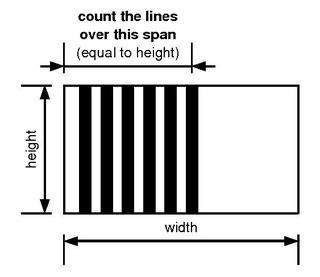Television lines

Television lines (TVL) is a specification of an analog camera's or monitors's horizontal resolution power. It is alternatively known as Lines of Horizontal Resolution (LoHR) or lines of resolution.[1] The TVL is one of the most important resolution measures in a video system. The TVL can be measured with the standard EIA-1956 resolution chart.[2]
Definition
TVL is defined as the maximum number of alternating light and dark vertical lines that can be resolved per picture height.[3] A resolution of 400 TVL means that 200 distinct dark vertical lines and 200 distinct white vertical lines can be counted over a horizontal span equal to the height of the picture. For example, on 4 by 3 inches (10.2 cm × 7.6 cm) monitor with 400 TVL, 200 vertical dark lines can be counted over 3 inches (7.6 cm) width on monitor (Note that the 3 inches (7.6 cm) of monitor height is used rather than the 4 inches (10 cm) of whole monitor width).
TVL is an inherent quality of a camera or monitor and should not be confused with the horizontal scanning lines of broadcast television systems, which e.g. for a PAL system are 625 lines, and for the NTSC system 525 lines.[3]
Limitations
Since analog transmission of video is scan line-based, the same number of horizontal lines is always transmitted. However, several factors impede the ability to display fine detail within a line:
- The camera or other source of material.
- The storage and processing of the picture.
- The transmission of the TV signal e.g. broadcast by radio or by cable.
- The reception and reproduction of the picture on a TV set.
See also
- Kell factor, which limits the vertical resolution in analog television, and both horizontal and vertical resolution in digital television, to a fraction of the number of scan lines or pixels
References
- ↑ Video Demystified. ISBN 0-7506-7822-4.
- ↑ "QA-70-1 Video Resolution Pattern (EIA-1956) Product Specifications" (PDF). Retrieved 24 May 2013.
- 1 2 "Overview and resolution". Wsc.monstercable.com. Retrieved 24 May 2013.